The Forgotten Volunteers of World War II
Published in 20th-century / Contemporary History, Features, Issue 1 (Spring 1998), The Emergency, Volume 6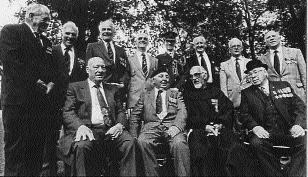
Southern Irish veterans commemorate D-Day in Normandy, 23 June 1994.
The relationship between Ireland, the Irish and Britain has always been complex. Such was the case during the World War II when the South was neutral. At the time there was a fierce defence of Irish neutrality. Indeed, by the end of the war neutrality had become almost a core value of Irish society, certainly among those who supported Fianna Fáil. At the same time, a large number of Irish citizens willingly went to Britain during the war, some to work, many others to join the armed forces.
The Volunteers Project
Based at NUI, Cork, the Volunteers Project is investigating the role and experience of Irish citizens who served
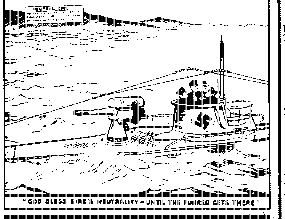
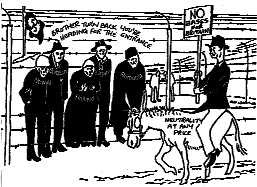
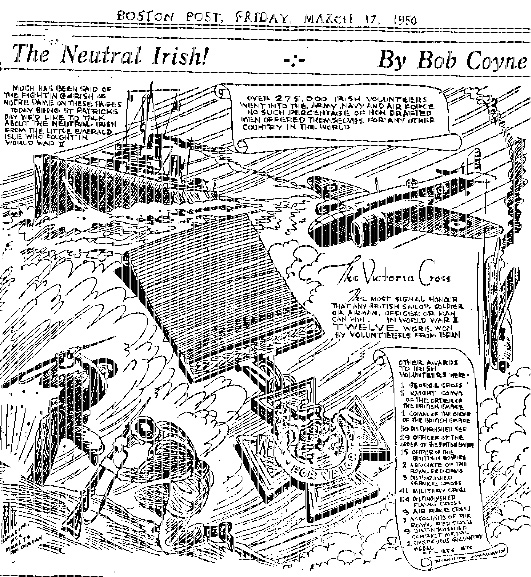
in the British armed forces during the war. In interviews with the project’s researcher, Tina Neylon, veterans recalled a spectrum of responses to their decision to join up—from open hostility to warm endorsement. But what most veterans remember is the silence. What they did was largely ignored by the Irish in Ireland. There are veterans who consider this appropriate, as they were fighting for another country, but most believed that their efforts were not just for Britain but also reflected a concern for Ireland and was not incompatible with patriotism or national identity. Nor were these veterans hostile to neutrality: for the most part those interviewed believed that neutrality was Ireland’s best policy.
Total figures on Irish volunteers and war workers remain uncertain, but the number of ‘new travel permits’, identity cards and passports issued to men and women in 1940-1945 was in the region of 200,000. To this should be added the 45,000 which the Department of External Affairs estimated went to the UK between September 1939 and the fall of France in June 1940, after which restrictions were imposed. In other words, out of a total population of approximately 2,968,000 (1936 census), over 8 per cent emigrated during the war. This is all the more significant when it is appreciated that those living in agricultural areas and all those under twenty-two years of age were prohibited from leaving the state, except in exceptional circumstances. If those under fourteen and over sixty-five are excluded, the figure rises to over 13 per cent and if we factor in the restrictions on those under the age of twenty-two, the number who travelled may have been well over 15 per cent of the eligible population.
There is ample evidence that this exodus was a cause of concern for the government. In July 1942 de Valera wrote to Seán T. O’Kelly that he expected up to a quarter of a million Irish people in the UK to return to Ireland at the end of the hostilities, adding rather ominously that they would be looking for work. These concerns also led Seán Lemass to formulate radical and far-reaching proposals to regulate labour, leading eventually to his cabinet submissions in 1944 on full employment.
Yet publicly the government was reluctant to accept responsibility for the large numbers leaving the country, claiming that this was a process outside its control. This was a somewhat disingenuous claim, as ministers and officials were deeply involved in regulating the flow of labour between the two countries during the war.
War workers
Although denied by the government, the arrangements by which Irish labour went to work in Britain were carefully regulated by agreements between the two states. Churchill was suspicious of the large influx of Irish labour, but Bevin and other ministers recognised that Irish labour provided an important reservoir for war work. A British Liaison Office was set up in Dublin to operate the arrangements agreed between the two countries. Irish officials were critical of the British for offering better pay and conditions than in Ireland, considering that this would ‘spoil’ Irish workers and have consequences for the Irish state when they returned after the war. For the most part, however, Irish officials considered the arrangements a godsend. In 1940, the Department of Industry and Commerce drew attention to rising unemployment and reported that agitation was already underway by left-wing elements at labour exchanges. According to the Department, an agreement with Britain to allow workers to travel to Britain would benefit the state and the individuals involved:
It seems a reasonable view that if they cannot secure normal employment here during the present emergency conditions, which will probably grow worse, the Department should not refuse them the facilities and assistance which they seek to earn their livelihood elsewhere.
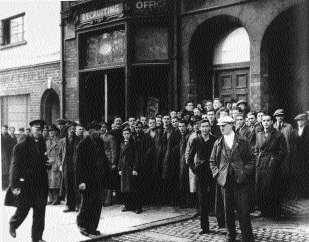
Central Recruiting Office, Clifton Street, Belfast-some sources suggest that up to 200 Southern Irish citizens were enlisting in Belfast per week. (Belfast Telegraph)
Rising unemployment was feared by the government because of its potentially destabilising effects politically. According to one official at the time ‘the placing of Irish unemployed workers in employment in Great Britain would provide a very welcome mitigation of the difficulties at home’.
The main concern of the Irish government was to allow Irish workers to go to Britain without being implicated in the process. Arrangements between Britain and Ireland were publicly represented as minimalist and disguised the fact that long-term and substantive arrangements were put in place. The government’s fear that they would be criticised was not unfounded. Fianna Fáil backbenchers, among others, criticised the methods used by the British to attract workers, and also feared that the Liaison Office was attempting to recruit for the British army.
By May 1942 procedures had been agreed for the movement of labour and this continued smoothly throughout the remainder of the war and, indeed, into the post-war period. The benefits of this arrangement were significant. It allowed the two governments to control the flow of labour to suit their purposes. For Ireland, it led to a considerable inflow of money into the country, which helped alleviate some of the hardship associated with the war. It also defused what might otherwise have been a difficult political situation at a time when other work was not available.
Military volunteers
While the motivation for going to the United Kingdom is self-evident for those who went for war work, there is more difficulty in explaining the actions of those who enlisted in the armed forces. Why did these Irish citizens join an army which many of their fellow citizens considered to be the nation’s historic enemy?
An easy answer is that they did it for the money, but it is difficult to credit that this was a major reason, as there was better paid (and less dangerous) war work available. A proportion were maintaining a family tradition of enlistment in British forces, especially in time of war. Some identified with the Empire and were motivated by loyalist sentiment, others were prompted by a more complex political identification with Britain while, perhaps, resenting Irish neutrality or indeed Irish independence. Yet the evidence suggests that loyalist sentiment influenced only a very small minority.
From the Project’s interviews and questionnaires, as well as other sources, it seems that the motivations ranged from family tradition, through anti-fascist sentiment, to looking for excitement and glamour, to avoiding trouble with the police. Common to virtually all was insistence on their Irish identity, reflected most significantly in support for neutrality despite their own decision to enlist. Some even argued that they were defending Ireland by their actions. However, that kind of argument and sentiment was not so apparent among those not resident in Ireland—those volunteers who didn’t return home and tended to have a more critical and distant attitude to their country’s role in the war.
Many Irish citizens who served in the war did not volunteer at all. Those in British forces at the outbreak of war in 1939 had little choice about the matter, short of desertion (British figures suggest that as many as 5,000 did desert during the war and returned to Ireland). Others who had been working in Britain for two or more years had the choice of returning to Ireland in 1939 or becoming eligible for conscription. Many in this category stayed in Britain and thus, in effect, volunteered.
The Irish government was reluctant to discuss publicly the large number of Irish citizens joining the British forces. Its position was that if recruiting did not take place openly the government would not put undue obstacles in the way of those volunteering. One fear was that neutrality would be compromised if the issue became a public one. Another concern was the danger of encouraging desertion from the Irish to the British armed forces (there were 5,000 such deserters).
The government seems to have taken few steps to control recruitment prior to 1940. Until then it remained possible for an individual to obtain a letter of introduction from the British Legion, a retired officer or an employer with connections in Britain. Such introductions were not without risk; in 1936 the IRA murdered Admiral Sommerville in west Cork for providing such references. In the context of World War II the references acted as travel permits into Northern Ireland. From 1941, the government discouraged anyone from providing letters of introduction, while the British Legion was warned explicitly not to engage in this activity. However, a report from G2 Branch (Irish Military Intelligence) concluded in 1943 that the Legion continued to provide references, though in a more discrete fashion than heretofore.
By 1943 the main objective of G2 was to discourage desertion from the Irish armed forces and to apprehend those who attempted to leave the state. G2’s efforts met with mixed success. In 1942 nearly three quarters of deserters were apprehended; however, during the first eight months of 1943 this had dropped to a third. This implied that those who wished to desert to the British side in 1943 were finding effective means of doing so.
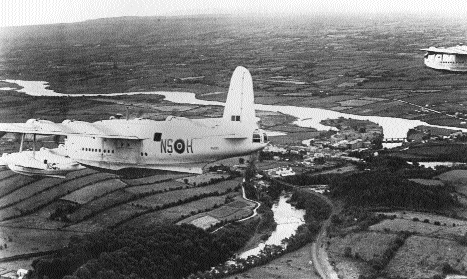
RAF Sunderland flying boats in 1945 over Beleek, on the Fermanagh/Donegal border, the last to avail of a flight corridor over Southern airspace under a secret 1941 agreement. (Ulster Aviation Society)
A number of factors were involved. Some members of the British Legion were in contact with military authorities in Northern Ireland and could secure safe passage from the South. In addition, it was common for an individual to arrange the specific date he would cross the border and arrangements were made to pick him up by the military authorities. It is also probable that deserters had by this time a more effective escape route out of the South which allowed them to leave undetected. It is also likely that most civilians who crossed into Northern Ireland to volunteer did so without the requisite travel permits from the Irish authorities. According to one source, he had family reasons for travelling to Northern Ireland during the World War II, but had considerable difficulties obtaining a permit. This, despite the fact that he had been born in the North, had family there and spoke with a strong Northern accent. The reason for this was that the Irish authorities assumed that any male of military age attempting to obtain a travel permit was doing so to enlist. Some sources suggest that up to 200 Irish citizens were enlisting in Belfast per week, especially in 1944 and 1945. If these figures are accurate it would mean that about 10,000 people per annum were recruited in this way and crossed the border in a clandestine fashion. Official Irish sources, on the other hand, indicate that between 1943 and 1945 only 771 travel permits were issued to males going to Northern Ireland.
The Irish government drew a distinction between those who provided references for members of its armed forces, which was illegal, and those who did so for civilians.
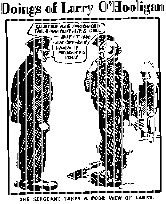
According to one official source, ‘it is clear that while individuals are facilitating or assisting prospective recruits for the British Forces in a variety of ways, the formal act of recruiting takes place across the border’. It was clear to Irish security personnel that short of introducing new and draconian legislation to prohibit Irish people from joining a belligerent power’s armed forces, little could be done to prevent those wishing to leave the state from doing so.
The numbers game
As the war progressed the Irish government recognised that it could benefit diplomatically from the number of Irish who had volunteered for the British forces. The actual number involved became a point of political controversy during 1944 and this debate was to continue for some time thereafter. In a letter to The Spectator in March 1944 the High Commissioner for Ireland in a reply to a critical editorial on Irish neutrality drew attention to the fact that:
No difficulty or hindrance was placed in Éire in the way of those who wished to join the British Army. The large number of Irish who thus volunteered represents a considerable proportion of Éire’s population—especially in the military age group and a good many of these volunteers have, as you know, outstanding achievements to their credit.
This defence is an interesting one and is, we believe, the first public statement of this position. It came at a time when the South was under considerable pressure—from the United States, in particular—to modify its neutral position.
By the end of the war various claims were being made about the number of Irish citizens who had enlisted.
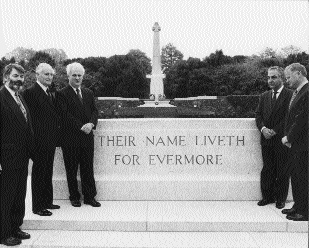
Taoiseach John Bruton speaking at the Irish National War Memorial Park, Islandbridge, Dublin, 28 April 1995. (Royal British Legion, Republic of Ireland)
In some cases this was given an anti-partitionist edge by claiming that far more had volunteered from the South than from the North. Sources as diverse as the Belfast Newsletter, the Irish Press, nationalist politicians in Northern Ireland, American diplomats, and news reports from New Zealand reported very high figures for Southern Irish enlistment and the apparently low recruitment among the Northern Irish population. Indeed in 1945 a Soviet expert in Moscow was reported as having cited a figure of 200,000 Irish volunteers in what was an otherwise critical talk on Ireland (The Soviets were as anti-Irish neutrality as the Americans and the British).
British officials were disturbed by these claims, in part because they did not believe the figures, but also because they were concerned about the impact on Northern Ireland. It was believed in Britain that the figures had been planted as part of an ‘insidious type of propaganda’ on behalf of the Dublin government. A ‘false impression has been encouraged by those who have made it their business to write up Éire’s war effort’, wrote one official. As a consequence the Dominions Office decided to systematically collect the figures. This proved difficult and the data from the air force and the navy was considered largely unreliable. Figures for the army at the end of 1944 were, however, believed to be quite reliable:
Officers Other Total
ranks
South 3,493 24,347 27,840
North 2,414 24,165 26,579
While it was noted in the report that the South had a larger population than the North, implying that this might account for the difference in the former’s favour, a cryptic note added to the text pointed out that ‘Éire was neutral while Northern Ireland was not’. At the end of December 1944, figures for the three services were provided which concluded that 37,440 men and 4,510 women born in the Twenty-Six Counties were in the armed forces, the figures for Northern Ireland were 37, 579 and 3,081 respectively. During 1945 the figures for the South were increased to 50,000.
In June 1945 the Irish Press under the heading ‘Crusaders?’ sneered at the unionist contribution to the war-effort, claiming that a majority of those who enlisted in Northern Ireland were in fact Catholics. An acrimonious exchange followed, which produced more heat than light, and very little new evidence. Nor did the new Labour government change the direction of the debate. Viscount Addison at the Dominions Office corresponded with Earl Granard, whose home was in County Longford, on the numbers involved. Granard did not accept the figure of 40,000, but Addison confirmed privately that this was indeed the case. During the course of 1946 the Dominions Office became increasingly concerned about the claim that as many as a quarter of a million Irish people served in the armed forces during the war. The worry was enhanced by a report that de Valera ‘is one of the dupes of his own propagandists and really believes that his country sent 180,000 men to join the United Kingdom forces’.
The momentum was maintained when Sir Hubert Gough wrote to The Times in April 1946 insisting that the official figures were incomplete and misleading. He in turn asserted that ‘I have confidential, but trustworthy information that in August-September 1944, the official lists of next-of-kin notifiable in case of casualties contained upward of 165,000 addresses in Éire’. This was followed up by a three page document circulated by the Commonwealth Irish Association and signed by ‘HH’ affirming the much higher figure. This was entitled ‘How Many?’ and argued a most impressive case for figures higher than those provided by the British government. There are difficulties with this, however, as HH seeks not only to include those who left the South to enlist, but all Irish resident in Britain in 1939 even if they do not have next-of-kin addresses in Ireland. While this is perhaps too wide a range, some important points are made in this document. Attention is drawn to those already in the forces in 1939, as well as to Irish citizens who remained in Britain after September 1939 and who enlisted or were conscripted. Additionally, and most importantly, HH highlighted that until 1 January 1943 Irish citizens enlisting in Northern Ireland were not designated as originating in the South. A further consideration is that there was significant under-reporting of place of domicile when Irish citizens enlisted in the United Kingdom. What is of interest is that those promoting the Irish case wanted a list of those with next-of-kin addresses in the South; to the best of our knowledge, this was never supplied. British documentation suggests that this was an impossible task, though this was contested by Gough, HH and others.
At this stage of research the statistical question remains unresolved, requiring further work in the archives which we hope will reveal more comprehensive and accurate figures. It is not necessary to accept the figure of 165,000 to argue that the number of enlistments may very well have been significantly in excess of the conventional figure of 50,000. A major flaw in the official figures is the failure to record volunteers from the South recruited in Northern Ireland. Even on a conservative estimate, a further 20,000 might be added to the official figures, taking this factor into account.
Figures far in excess of the official statistics continued to circulate for a decade after 1945, especially among expatriate Irish communities. It is difficult to assess whether they had any impact on Irish diplomatic efforts to improve its standing in the international community as Ireland’s isolation continued into the 1950s. However, the emphasis on Irish participation in the war did not extend to domestic politics. The government decided to prohibit the Remembrance Day march in November 1945—ostensibly on the grounds of public order, but more likely because it did not wish to see any public expression of Irish involvement in the Allied war effort.
James Dillon (who opposed neutrality during the war although he subsequently modified his position) attacked the decision in the Dáil, arguing that the grounds for doing so were spurious and dangerous. In an emotional speech, quoting the poetry of Tom Kettle at length, which revived memories of those who fought in World War I, Dillon accused the government of authoritarianism and of a refusal to defend the rights of a minority in the state. Another deputy, James Coburn, concluded that ‘this country may after all become the last citadel of Fascism if we start banning processions without any just cause’. The government’s discomfort was palpable in the Dáil, but its political intention was clear: those who fought in the war were to be ignored by the Irish government no matter what their motivation.
Recognition
It was to take another fifty years before the involvement of these Irish citizens in the British forces began to receive full recognition. In April 1995 the then Taoiseach John Bruton spoke movingly of 150,000 Irish people from North and South who volunteered to fight the Nazis. He pointed out that 10,000 had died while serving in the British forces. This had a particular significance he maintained:
In recalling their bravery, we are recalling a shared experience of Irish and British people…We remember a British part of the inheritance of all who live in Ireland.
While such sentiments might not be supported by everyone, the significance of the Taoiseach articulating them at Islandbridge in the company not only of all the political parties in the Republic, but also the Alliance Party, the Ulster Unionist Party, the SDLP and Sinn Féin cannot be denied. Such a speech will not remove the divisions among those represented at the memorial ceremony, but the recognition that those who volunteered to fight for Britain in World War II did so for honourable reasons may in the longer term contribute to a fuller appreciation and interpretation of the complexities of Irish and British relations at the time.
Brian Girvin is Senior Lecturer in politics at the University of Glasgow and Geoffrey Roberts lectures in history at NUI, Cork.
Further reading:
B. Barton, Northern Ireland During the Second World War (Belfast 1996).
R. Fisk, In Time of War: Ireland, Ulster and the Price of Neutrality, 1939-45 (London 1983).
D. Ó Drisceoil, Censorship in Ireland, 1939-1945 (Cork 1996).
Special issue of The Irish Sword on ‘The Emergency, 1939-45’, vol.XIX, nos.75 & 76 (1993-94).
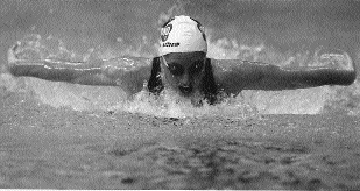
Ireland’s most successful Olympian Michelle Smith in action. (Irish Times)
















